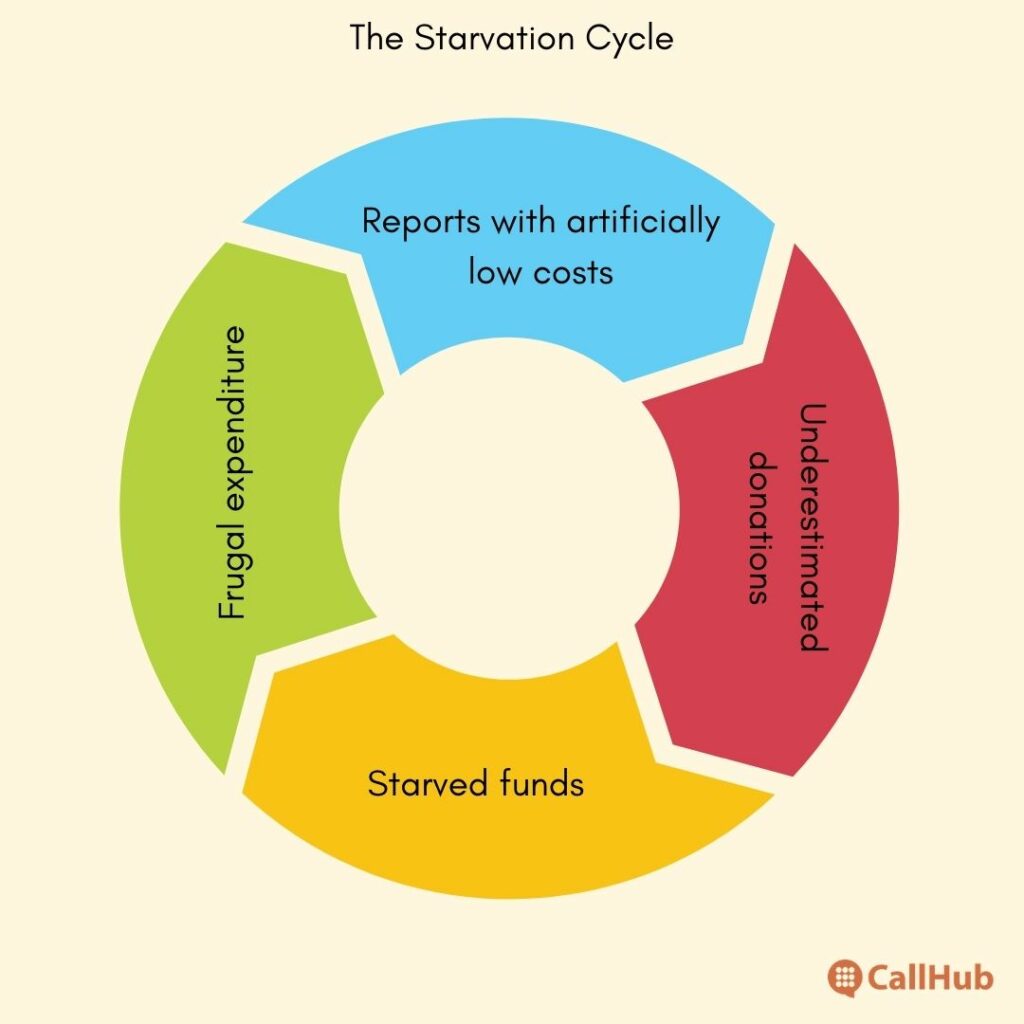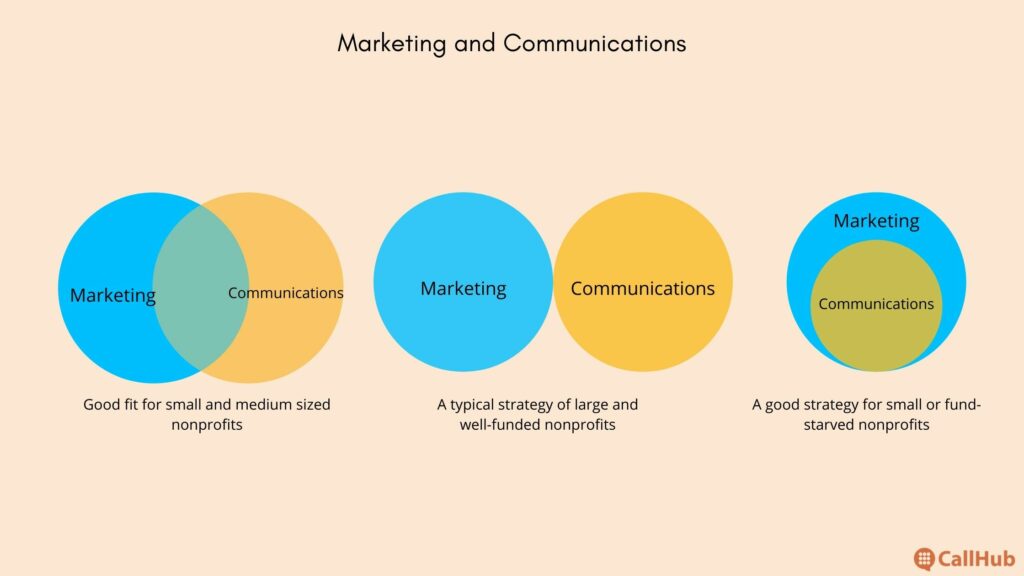Table of Contents
If marketing and communications are overhead expenses, why should you spend time setting a nonprofit communications budget?
Because, by failing to do so, you are initiating a snowball effect towards a nonprofit starvation cycle.
According to the Stanford Social Innovation Review, this cycle starts when a nonprofit reports artificially low overhead costs to major donors and funders. Consequently, funders don’t know the exact amount needed and end up donating underestimated amounts. This leads to starvation of funds and scrambling of budgets.

Without a proper communications budget, a nonprofit suffers in the following ways:
- There’s ambiguity about the expenditure on marketing and communications.
- This results in budget allotment on an initiative-basis (modest amounts allotted to individual outreach/marketing instead of crafting a proper nonprofit communications plan.)
- As a result, it gets difficult to track the ROI of your outreach and marketing efforts.
One in every five nonprofits is guilty of this sin.
This brings us to two questions:
- How much should a nonprofit spend on communications?
- How should they set this budget?
Let’s get the answers!
How much do nonprofits spend on marketing and communications?
2018 saw a 20% increase in the overall media expenditures incurred by small nonprofits. By contrast, larger nonprofits increased this marketing budget by just 3%. Smaller nonprofits reserved 30% of their spending for digital media, while larger organizations used 7.4%.
Overall, nonprofits usually spend much less on marketing and communications as compared to brands and businesses. The nonprofit sector claims only 1% of the $730 billion spent annually on marketing in the USA.

While nonprofits tend to spend much less on marketing and communications, it is still necessary to fix a budget to determine costs and expected returns. Let’s take a look at the procedure you can follow to determine your nonprofit’s communication budget.
Communications budget definition:
Defining your communications budget and marketing budget will help your nonprofit allocate funds accordingly. But first, it’s essential to understand what each entails and how they are related.
Marketing budget: This refers to all costs incurred by advertisements, promotions, marketing initiatives, and public relations.
Communications budget: This budget is set aside to spread a particular message instead of educating and advertising. This also budgets for personal or one-on-one communications.
Marketing and communications budgets can be:
- Distinct: When your advertising and personal communications do not intersect.
- Overlapping: When some of the initiatives intersect but not all.
- One: When all your initiatives under marketing and communications are the same.
By defining communications for your organization, you can determine how big a slice you require from the marketing budget (or if the marketing budget is your communications budget).
How much should nonprofits spend on communications?
According to Nancy Schwartz, a marketing and communications consultant from New York, nonprofits should spend 10-20% of their budget on marketing. This feels like a huge number, considering how much you need to spend on fundraising, human resources, and other daily expenditures.
However, this percentage is necessary if your overall marketing also involves the whole or some of your communications strategies.
Alternately, Schwartz suggests integrating the budget with individual program budgets. This means you don’t set aside separate funds for your nonprofit’s overall marketing but rather account for individual marketing for each program and leave a slice out of the program budget for marketing and communications.
There’s another way to go about your organization’s communications budget when you want to allocate separate funds for communication and outreach.
Study your nonprofit’s current situation and determine the share of the marketing budget you want to reserve for communications.
For instance, if your marketing budget is shrinking this year due to a lack of returns, shrinking the communications budget would be counterproductive. If you want to reduce nonprofit advertising, your personal messaging should go up.
This is true even when (no, especially when) your nonprofit is suffering from massive losses.
As Henry Ford said, “A man who stops advertising to save money is like a man who stops a clock to save time.”
At this point, you need to get in touch with your current donors, retain them and motivate them to donate again or donate larger amounts.
In essence, you reserve an amount for marketing and communications from the overall expenditure. If marketing tactics are failing and budgets for them are cut, communications should take up that portion and vice versa.
In hey-days, communications are more relaxed. But no matter how well or poorly you are performing, a nonprofit communications budget should entail funds for:
- Outreach to new donors
- Nurturing existing donors
- Donor retention
- Major donor cultivation
- Donation appeals
- Outreach to lapsed supporters.
Now that you know how much you should account for communications from your nonprofit marketing budget, let’s look at the steps to set it.
How to set a nonprofit communications budget?
Before setting the budget for nonprofit communications, you need to
- Analyze the resources already at your disposal.
- Identify the resources you need to spend on.
- Determine the maximum you can allocate.
Here are the steps to set a nonprofit communications budget:
Define your communications
For big nonprofits, marketing and communications can be separate departments, each with its own budgets and objectives. For smaller organizations, these efforts can be interlinked, overlapping, or a subset of the other.

Defining communications for your nonprofit involves three things:
- Determining their relationship with your marketing strategy.
- Outlining the objectives (e.g., outreach, nurturing, retention, etc.)
- Defining what communications entail (e.g., sending text blasts to contact lists, engaging in P2P texts for nurturing, or sending email surveys).
It is crucial to begin setting your nonprofit’s budget by defining communications to know your expenses and set realistic expectations from the investments.
Outline all your communication resources
Once you know what communications entail, the next step is to list your existing resources and those you need.
Everything is measurable, including social media boosts, cost per text, and ongoing day-to-day expenses. Nothing, no matter how cheap, should be excluded from this list. Here’s a list of communication resources that you may take inspiration from:
| Communication methods | Ways to use | Payable Resources |
| Text message | – SMS broadcasts – Peer-to-peer text – MMS blasts – SMS opt-in |
Subscription/Balance in the texting software. |
| Email marketing | – Nurturing communications – Surveys/Feedback – Event invitations – Sending receipts |
Subscription to email marketing and automation tools. Purchasable contact lists. |
| Phone calls | – Phonathons – 1-on-1 calls to major donors. – Donor thank-you calls |
Subscription/account balance in the outbound calling software. |
| Social Media | – Paid advertising – Nurturing 1-on-1 communication with engaged followers – Sharing impact reports with the followers |
Funds for post boosts and paid ads. Subscription to integrate with other communication channels. |
| Letters/Direct Mail | – Donor appreciation letter – Fundraising letter – Donor thank you letter |
Stationery, mailing costs. |
At this point, you may also want to add other costs such as:
- Human resources costs
- Hardware costs (e.g., computers or phones if you don’t have enough.)
- Stationery (apart from what you require to send letters).
- Other day-on-day expenses.
Once you have this list ready and the overall costs in hand, you can pencil in the details such as quantities, brands, what items can be sponsored, etc.
Separate communications budget and program budget
Categorizing efforts as part of communications or specific programs releases some burden from your nonprofit communications budgets without letting go of essential touchpoints. There’s a simple way to determine whether an effort is part of the communications or a program:
If an initiative, advertisement, or effort is used for only one specific program, it is a direct program cost.
For instance, if you send thank you letters to supporters of a particular program and no one else, the cost can be borne by the program budget.
On the other hand, if an effort helps two or more programs and comes under the purview of communications, it forms part of the communication budget. For example, if you send a text survey to donors who supported any fundraiser in the past quarter.
Finalizing your nonprofit communications budget
If you follow Ms. Schwartz’s advice, your nonprofit marketing budget should be about 10-20% of the total expenditure budget. Even other expert estimates put this number to 5-15% of the total budget.
Here’s how you can go about setting your nonprofit communications budget:
- If you are experimenting with nonprofit communication strategies, start by allocating 2-3% of this budget to communications.
- Now, go through your resource list and see how much of it these dollars can buy. For instance, say you have a marketing budget of $25,000. The communications share from this would be $500-750. Even before you go through the list, you would know that this amount won’t buy much.
- In such cases, where the marketing budget is <$25,000 or required communication resources are high, you can start with a larger share (e.g., 8-10%).
- Prioritize your resources and communication channels based on what your supporters prefer and invest your funds accordingly.
- The first cycle should inform you of what channels, methods, and strategies are working and failing. Calculate the ROI on each.
- In the next cycle (monthly or quarterly), tweak the share by 3-5%. Go through the exercise of prioritizing resources once again. At this stage, drop what is not working to make space for new experiments or better resources.
- The graph should grow steadily. Once it plateaus, that is your optimum communications budget share from the marketing budget.
If your nonprofit has set communications strategies, you need not go through this entire exercise. You can calculate the funds required and if the marketing budget is adequate, take the portion from it. If it isn’t sufficient, you may want to compromise on a few resources.
The nonprofit communications budget is ideally never a blanket amount or percentage. It should differ seasonally, as your strategies, channels, and investment fluctuate. For instance, if you have escalated to 20% to accommodate fundraising letters in Q3, but traditionally, letters haven’t worked for you in Q4, it’s best to pull back that amount and let the marketing team use the funds for promotions.
To Conclude
Once you have the final nonprofit communications budget in place, the next step is to craft an efficient communications plan with specific objectives and an action plan to achieve them. These best practices will help you build a meaningful strategy and use only the most effective channels to keep in touch with supporters: Nonprofit Communication Best Practices To Make Communications More Impactful.
Feature Image Source: Annie Spratt/Unsplash.

